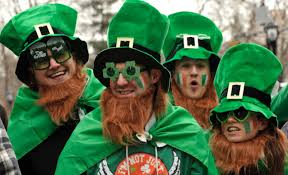Bernice Afriyie | Arts Editor
Featured image: Many religious holidays have a colour theme that allows for secular consumption. | Courtesy of Wikimedia Commons
It’s spring and with the change of seasons and colours comes rain, blossoming flowers and leprechauns. Pots of gold, three-leaf clovers and short green-clad men are common stereotypical images that popular culture associates not only with Irish culture, but St. Patrick’s Day as well.
On March 17, St. Patrick’s Day and the celebrations the day entails have become increasingly commercialized over the years as cultures all over the world approach the Catholic feast of the patron saint of Ireland in secular ways.
St. Patrick’s Day is a public holiday originating in Ireland, with many Irish diasporas around the world that celebrate the day, such as in Newfoundland and Labrador. Saint Patrick, who was born in what would today be known as Scotland, ended up in Ireland and converted to Christianity when he was enslaved by Irish pirates.
As is the case with many holidays celebrated for religious or secular reasons such as Christmas, Easter, Halloween or Valentine’s Day, there are colours that we have come to associate with each day: red and green for Christmas, yellow and purple for Easter, orange and black for Halloween, pink and red for Valentine’s Day and green for St. Patrick’s Day. For each of these holidays, the use of colour, whether they be complementary, monochromatic or individual, plays an important part in marketing.
For the purpose of marketing holidays with a religious history, such as St. Patrick’s Day, the commercial emphasis of the colour green provides a general framework that is easier for more people to identify with—through McDonald’s shamrock shakes, leprechauns in green suits or other marketing schemes. It is expected that over 80 per cent of Americans this year are planning to wear green on St. Patrick’s Day this year.
The association of the colour green with St. Patrick’s Day started before the commercialization of this connection. The colour green has been a part of Ireland since the 15th century, when the green harp flag was used by the Irish Confederation. The flag is a deep green with a silver stringed gold harp in the centre.
The tradition of wearing green shamrocks and ribbons dates back to the 1680s, but was disrupted when the Order of St. Patrick was founded in 1783 and adopted blue as its colour. Even so, the colour green remained as a sign of Irish nationalism, but it wasn’t until the popularization of St. Patrick’s Day’s festivities starting in the 19th century that the Western association of green with Ireland occurred.
It could be argued that colour played a role in St. Patrick’s Day reaching secular popularity, or that commercial popularity simply solidified the relationship. Spike Bucklow, a research scientist at the University of Cambridge, suggests that because people experience over-colour-saturation on a daily basis, colours no longer have meaning. As such, marking holidays such as Christmas with red and green, and likewise, St. Patrick’s Day with green, represents a desire to recognize the deep history of these days.
If colour choice is meant to acknowledge the history and tradition of St. Patrick’s Day, it has also opened up the feast day for secular consumption.


